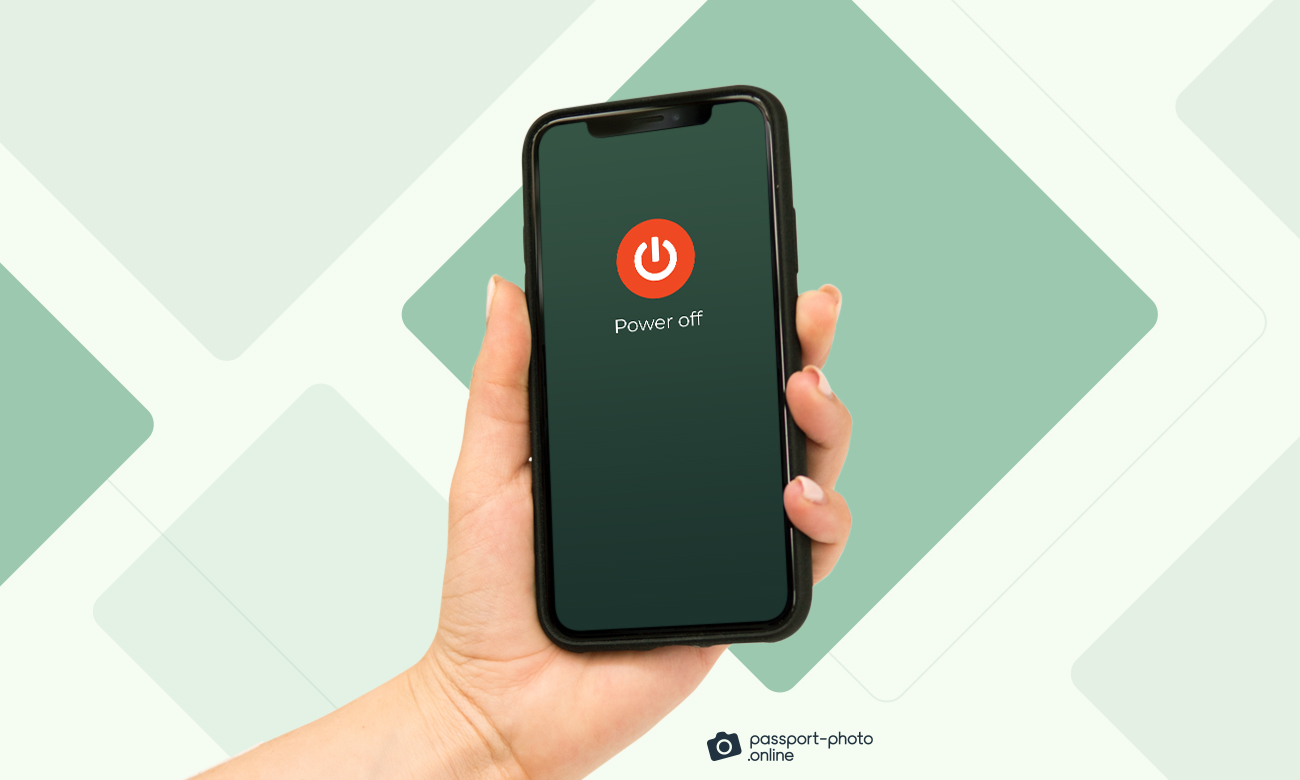Can you remember the last time you spent a day without a smartphone?
Exactly.
But we don’t blame you.
It isn’t easy to get around without these devices in today’s digital era.
That’s why we’ve decided to reach out to 650+ Americans and get the scoop on their tech habits. Learn how addicted we’re to technology, our experiences with a digital detox, and much more.
Let’s dive right in:
Key Takeaways
- Around 66% of Americans consider themselves addicted to technology.
- Every eight in 10 people spend 3+ hours daily on their gadgets for leisure.
- Over half of Americans (53%) would command between $3,000 and $5,000 if asked to give up their gear for just one week.
- Over 60% of respondents have taken a digital detox at least once in their lifetime.
- The smartphone (39%) is the most challenging gadget to disconnect from.
- Working professionals grow more productive (86%) and creative (73%) in workplaces with a digital detox policy.
- Roughly 66% of employees will give preference to companies with digital detox policies when looking for a new job.
Technology Addiction Is the New Normal
There are a few things we don’t mind overusing.
Let’s take coffee. According to the National Library of Medicine, 90% of Americans consume it regularly, making caffeine the most widely used drug in the country.
But how do things stand with technology?
To find out, we first asked survey respondents how much time they usually spend daily using all their digital devices for personal purposes.
The results are in:
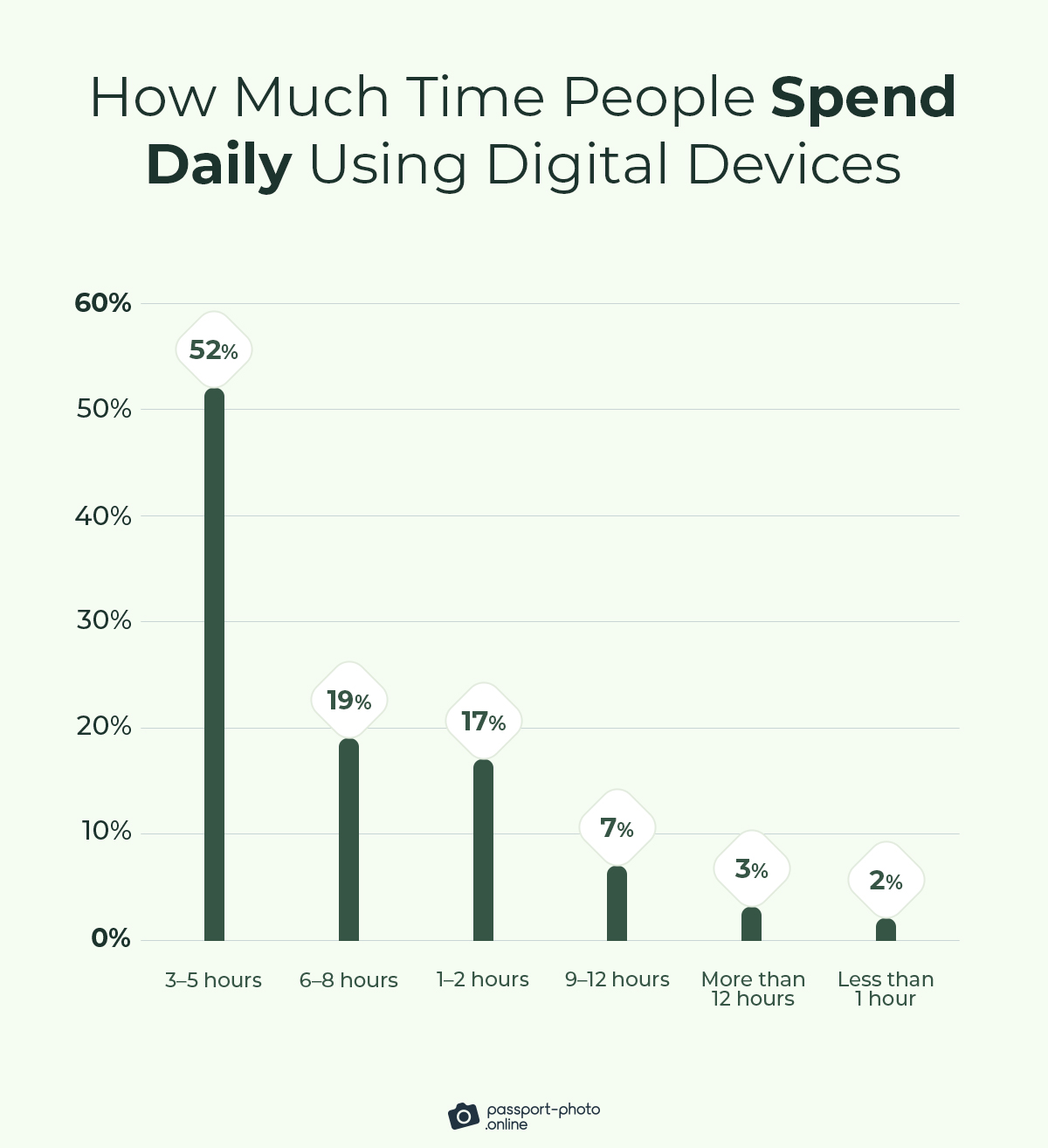
That data shows that most people (52%) spend between three and five hours daily using their devices.
Is that too much or just enough?
Over half of respondents (55%) believe it’s just what the doctor ordered.
Yet—
The World Health Organization recommends no more than two hours of screen time for adults outside of work.
So it may be time to dial back on our tech use.
Except it’s easier said than done, given that ~66% of pollees said they consider themselves addicted to their gadgets, according to our further findings.
Yikes.
Curious to learn about mobile app usage statistics? Check this study.
Most Americans Would Command $3–5K if Asked To Give Up Devices
What’s the first thing you reach for when you wake up?
Chances are, you said, “smartphone.”
That’s because our cells are an integral part of our lives. We use them to text, swipe, and scroll.
But—
What if somebody asked you to stay away from all your personal devices for a week? How much would you charge for such forced abstinence?
Our study reveals that most people (31%) would command between $3,000 and $5,000.
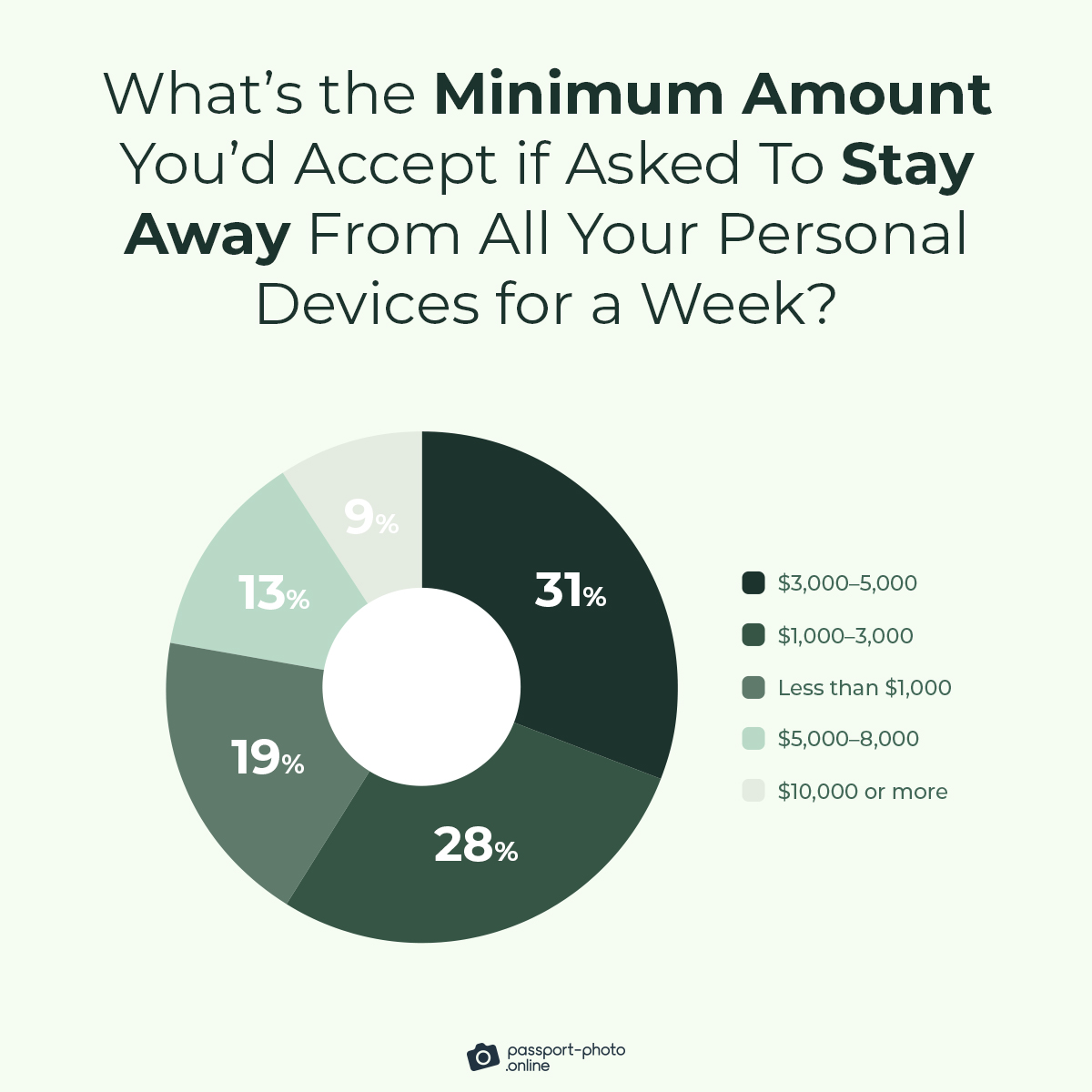
That’s a lot of cash.
Over Half of Tech Users Have Taken a Detox
As much as we love our devices, they can sometimes be overwhelming.
They can lead to psychological and physical issues (e.g., eyestrain, difficulty focusing) and contribute to more severe health conditions like depression, according to Medical News Today.
So—
When we asked survey respondents if they’d ever taken a voluntary digital detox, we weren’t surprised that most (62%) answered in the affirmative.
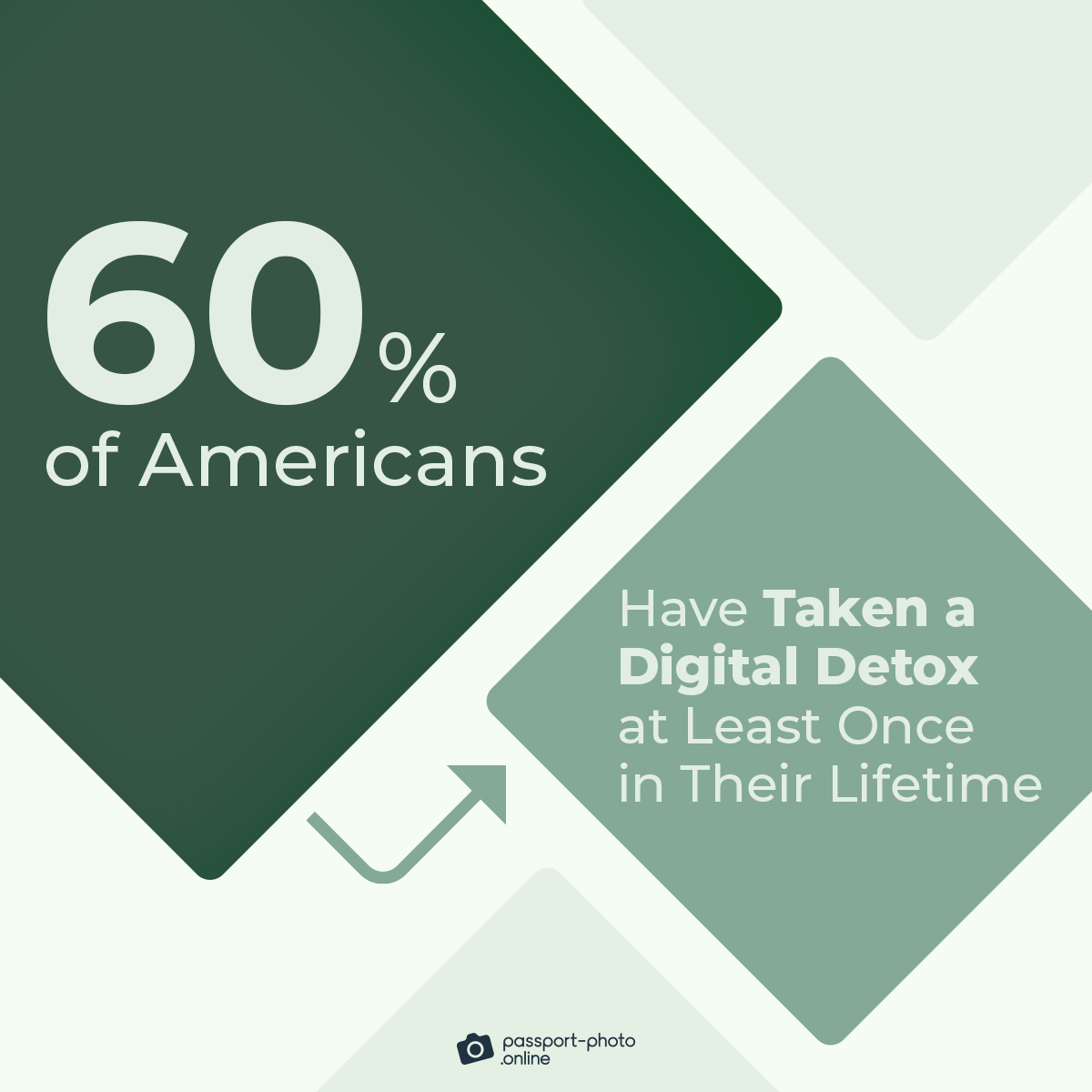
Below is a rundown of the exact reasons why Americans choose to unplug:
| Reasons To Take a Digital Detox | Share |
|---|---|
| To improve one’s mental and/or physical well-being | 36% |
| To reconnect with the offline world (e.g., spend time in nature) | 19% |
| To focus on offline social interactions | 16% |
| To avoid developing addictive habits and/or behaviors | 15% |
| To sleep better | 14% |
Indeed, the leading motivation to disconnect is to enhance one’s mental and/or physical well-being (36%).
It’s followed by the desire to reconnect with the offline world at 19%.
Now—
If you’ve ever taken a digital detox, what was your primary motivation for it? Let us know in the comment section below.
Keeping Devices Out of Reach Is the Top Way To Break From the Digital World
You might think a digital detox implies pulling the plug on gadgets entirely.
But—
It’s not the only way.
Our results show that the most common approach to managing tech use is keeping one’s devices out of reach (23.5%).
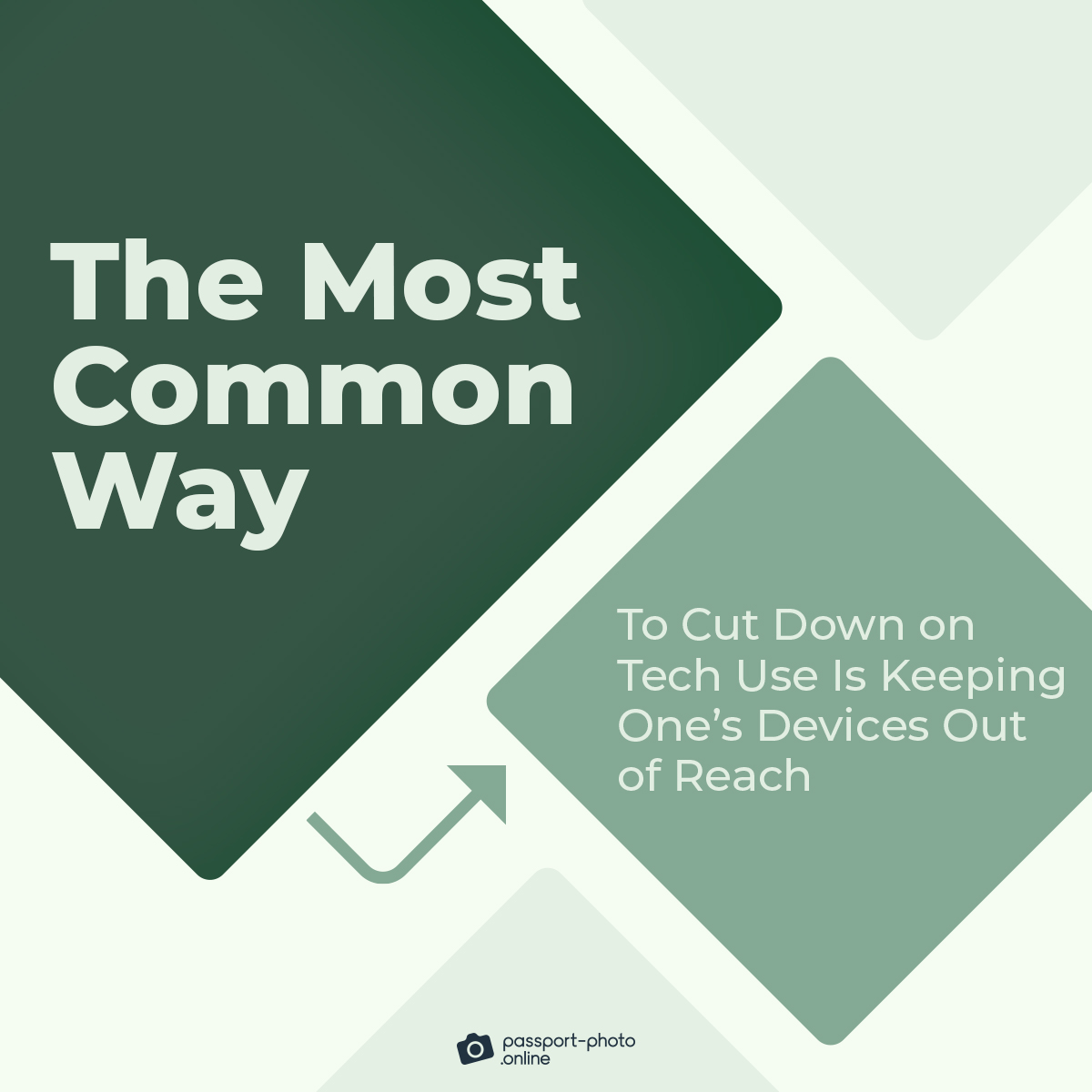
Here’s also a list of other techniques Americans use to reduce screen time, ranked by popularity:
| How Do You Typically Cut Back on Tech Use? | Share |
|---|---|
| Keep one’s devices out of reach | 23.5% |
| Adjust one’s settings to limit certain apps | 20.9% |
| Schedule time away from screens throughout the day | 19.9% |
| Mute notifications | 19.3% |
| Turn off digital devices at a specific time | 18.5% |
| Create no-tech areas at home | 17.2% |
| Log out of social networks | 16.4% |
| Replace one’s smartphone with a simple cell phone that can’t support apps | 16.1% |
| Delete certain apps | 13.6% |
The Smartphone Is the Most Challenging Device To Disconnect From
Not all gadgets are created equal.
Take stock of all your devices, and you’ll likely find that one piece of technology is particularly difficult to put down: your iPhone or Android.
Our survey results prove it:
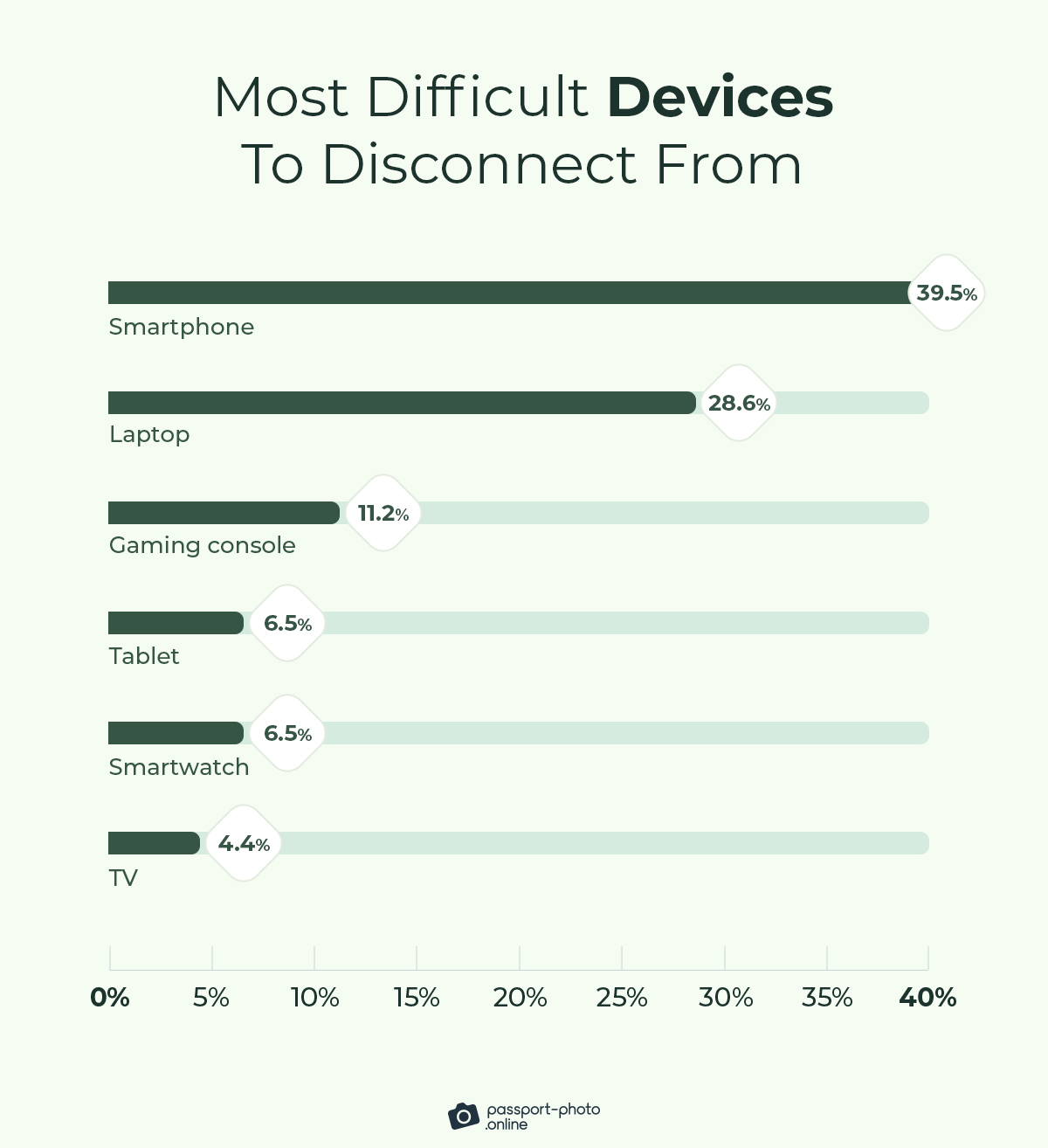
That’s not exactly a shocker.
After all, the average American checks their phone 96 times per day, or once every 10–12 minutes, based on Zippia’s data.
That’s a lot.
A Detox Lowers Stress and Anxiety
Unplugging from technology is no easy feat.
Yet—
Its positive effects could be worth their weight in gold.
To see if that’s the case, we asked survey takers what positive effects they noticed after their most recent detox AND how long they lasted.
Here’s what we found:
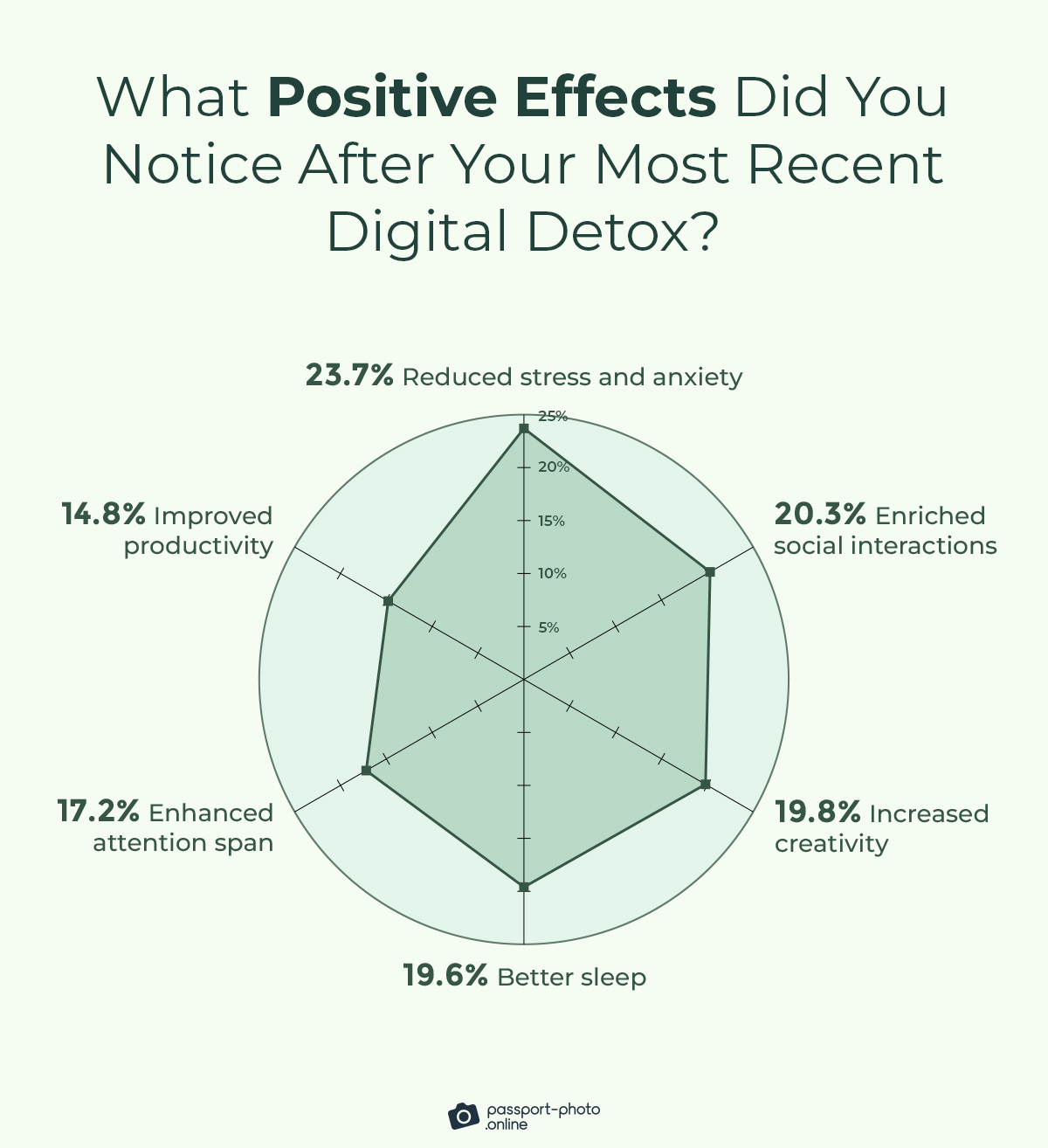
The chart shows that a digital detox helps reduce stress and anxiety (23.7%) and improves the quality of social interactions (20.3%).
The not-so-good news?
Most respondents (43%) also reported that the positive effects of unplugging usually last 2–3 days.
That’s little time to reap the benefits.
So it’s a good idea to cement occasional detoxing into our everyday routines to keep the positive impact going.

Looking for passport photos? Discover more information:
Social Pressure Is the Most Common Downside of a Detox
Every coin has two sides.
As we’ve just seen, digital detoxes can help keep stress and anxiety levels in check and up the quality of social interactions.
But—
They also come with potential downsides:
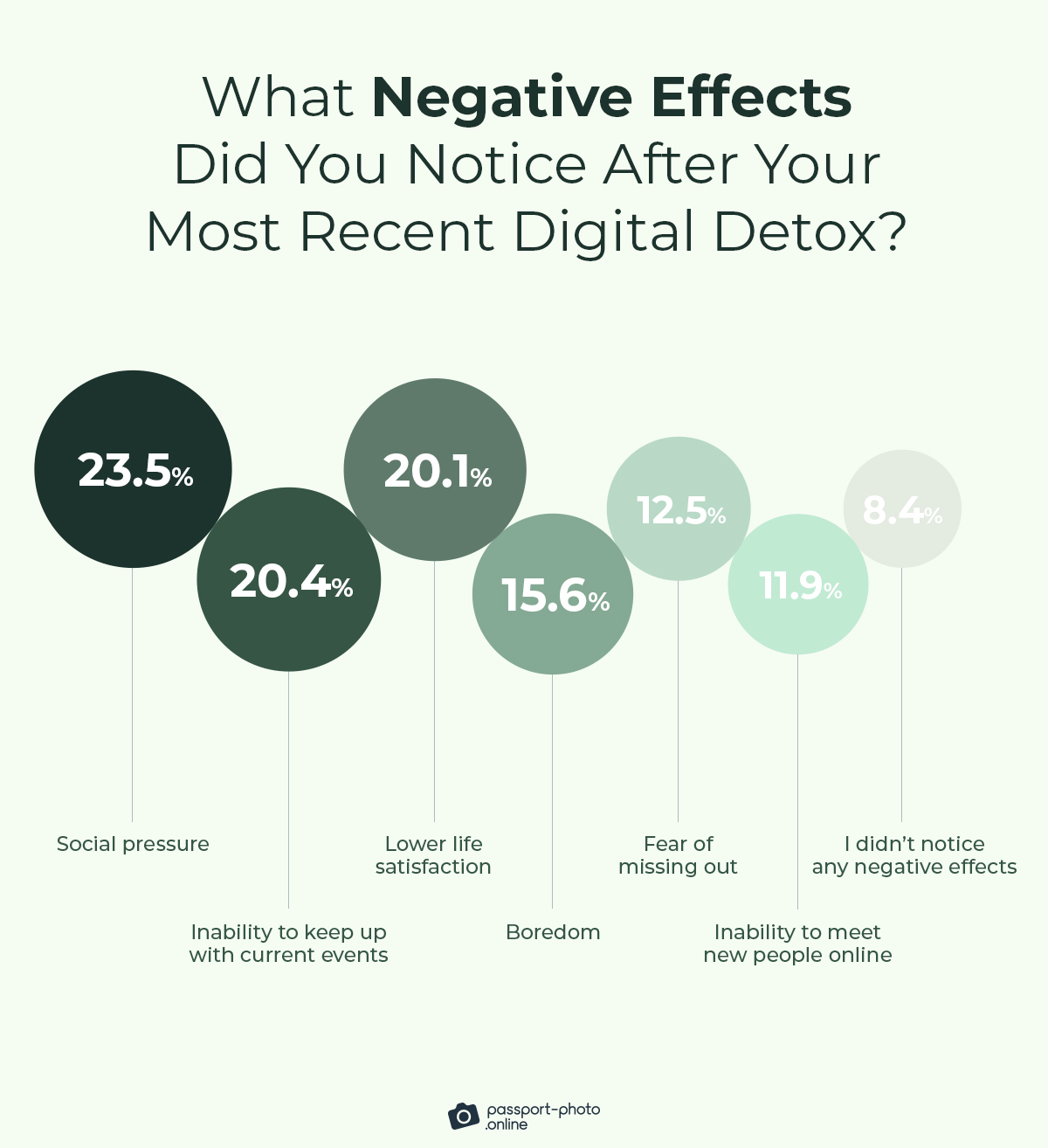
As you can see, social pressure (23.5%) and the inability to keep up with current trends (20.4%) top the list.
That’s something to consider before you hit the “unplug” button.
A Technology Detox at Work: Everything You Need To Know
In our last section, we want to focus on a workplace digital detox.
Such a policy promotes device breaks through no-tech meetings, leaving work laptops in the office when the clock strikes 5 PM and more.
So—
We turned to survey respondents whose employers had adopted the policy and asked them if they were satisfied with it.
The results are in:
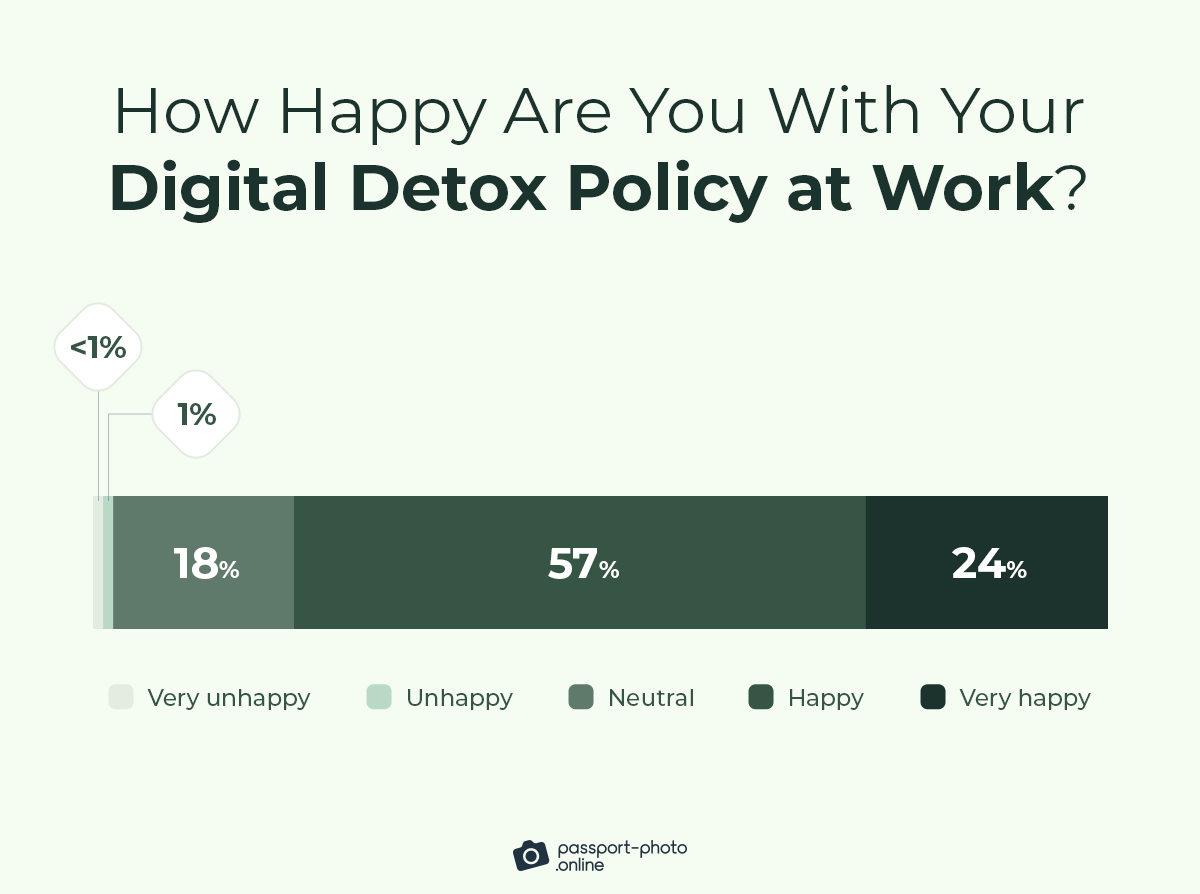
Our research shows that over 80% of Americans are happy or very happy about the policy. So much so that 66% of respondents later indicated they’d prefer employers with a robust digital detox policy in the future.
Wow.
As a follow-up, we asked survey takers how their organization goes about a digital detox.
Let’s have a look at the answers:
| How Does Your Company Go About a Digital Detox? | Share |
|---|---|
| Encourages staff to leave devices (e.g., work laptops) in the office when going home | 17.9% |
| Limits access to email and team chat apps | 17% |
| Promotes turning off notifications | 16.2% |
| Introduces activities to help employees disconnect from digital devices (e.g., yoga classes) | 15.9% |
| Encourages one-screen limits, screen breaks, and tech-free windows | 15.7% |
| Restricts or blocks access to social media | 12.2% |
| Holds no-tech meetings | 9.9% |
Finally, we wanted to examine if rolling out a workplace digital detox policy comes with an added bonus in the form of improved productivity or creativity.
So we asked Americans to indicate how much they agree OR disagree with the following statements: “A workplace digital detox increases my productivity” and “A digital detox policy at work enhances my creativity.”
Here’s what the data revealed:
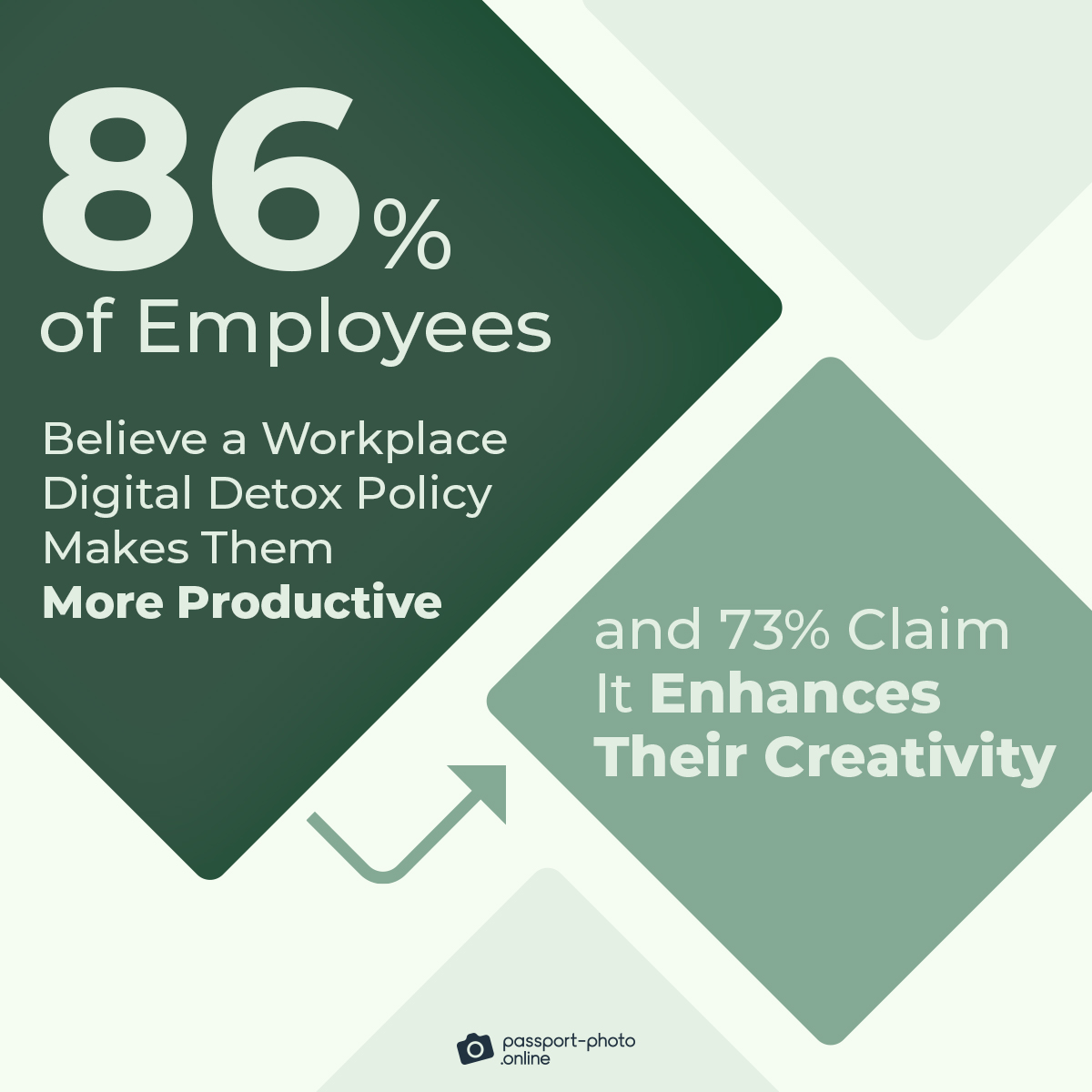
Sounds too good to be true?
While a digital detox is by no means an antidote to low productivity or lack of creativity, there are several reasons why it can be valuable.
Take, for instance, the idea of encouraging staff to leave laptops in the office when going home.
It’s something that SoftGrid Computers (a software company) does. Once the workday ends, a message pops up on the employees’ computer screens that reads,
“Your shift time is over. The office system will shut down in 10 mins. PLEASE GO HOME!”
This initiative has come to public attention thanks to a now-viral LinkedIn post shared by one of the company’s new hires, which has raked up over 434K likes (as of writing).
Now—
There’s no empirical evidence this approach has yielded a boost in productivity or creativity.
But it’s not hard to see how striking a better work-life balance can positively affect job performance.
So employers, take note!
Stacking It All Up
There you have it:
A comprehensive look at Americans’ tech habits and their experiences with a digital detox.
Now—
Have you ever taken a digital detox? How did you manage your tech use?
Let us know in the comments below.
Methodology
We conducted an online survey of 656 US respondents via a bespoke online polling tool in February 2023.
The respondents were 52.4% male, 47.5% female, and 0.1% identified as other. 20.4% of respondents were 26 or younger, 34% were 27–35, 14.7% were 36–42, 23.5% were 43–58, and 7.3% were 59 or older.
This survey has a confidence level of 95% and a margin of error of 4%. Given the gender and age makeup of our sample size, the study’s findings are statistically significant for the population at large.
This study was created through multiple research steps, crowdsourcing, and surveying. Data scientists reviewed all survey participants’ responses for quality control. The survey also had an attention-check question.
Fair Use Statement
Did our findings help you learn more about digital detoxes? If you believe your audience will be interested in this information, feel free to share it. Just remember to mention the source and link back to this page.
Sources
- Alund N., “SoftGrid Computers Wants Its Employees To Stop Working Overtime”
- AnnMarie John, “How Spending Time Online Can Impact Your Mental Health”
- Flynn J., “20 Vital Smartphone Usage Statistics”
- Frary C., Johnson R., Wang M., “Food Sources and Intakes of Caffeine in the Diets of Persons in the United States”
- Hoehe M., Thibaut F., “Going Digital: How Technology Use May Influence Human Brains and Behavior”
- Hoshaw C., “Social Media Breaks: Benefits, Tips, and How to Set Boundaries”
- Johnson J., “Negative Effects of Technology: What To Know”
- Okeke N., “10 Negative Effects of Social Media on People & the World”
- Perna M., “How A Technology Detox Can Save You From Burnout”

As a Digital PR specialist and a member of the Society of Professional Journalists (SPJ), Max has 5+ years of writing experience.
Over the course of his career, Max’s work has garnered significant attention, with features in numerous prominent publications such as The New York Times, Forbes, Inc., Business Insider, Fast Company, Entrepreneur, BBC, TechRepublic, Glassdoor, and G2.
